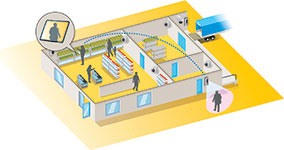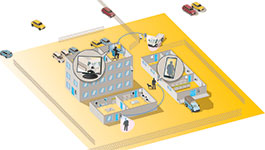
Pace and progress may differ, but industry after industry is adopting IP technology. The main driving forces behind this transition are usually economical as well as practical – on the whole, network-based solutions are smarter, more cost efficient and versatile than their analogue predecessors.
With the adoption of IP technology, and as more and more devices are based on a common, standardised communications protocol, it becomes possible to integrate different systems with each other, which is of great benefit to the customer and end user. Furthermore, standards ensure that products are future-proof and help to push development and manufacturing costs down.
This is especially true about the security industry, where IP systems are becoming widespread in areas besides video surveillance, e.g. sensor technologies and access control. Consequently, the now fast growing market and supply of various digital intercom products, such as video door stations, comes as no surprise.

The merits of the IP solution is apparent in video surveillance installations where multiple cameras and door stations can be connected to one operator station and integrated with the security system. Video door stations, or intercoms, are traditionally used to serve condominiums and office buildings, where a door station placed at the entrance is connected to several receiving stations. The introduction of IP-technology will not change that. However, there is a gap in the current market for a solution covering the needs of the typical security installations with one centralised point of operation and open standards for integration with other systems.
New technology, new possibilities
From a technical point of view, it is just as easy to transmit audio data over a network as it is to transmit video data. Intercom functionality is therefore a natural and readily accessible supplement to any video surveillance system.
Door stations are often installed in settings with surrounding noise and difficult lighting conditions. While the need for high quality audio is apparent the technology transition will enhance performance and quality of many video door phone products. For instance, IP enables video with HDTV quality, digital PTZ (Pan, Tilt, Zoom) and edge storage, as well as video analytics and great performance even in strong backlight or low light conditions. Installation will also be simplified, particularly for devices supported by POE (Power over Ethernet), since they handle both data transfer and power supply through the same single cable.

Historically, the intercom and the video surveillance industries have lived parallel but separate lives, with very few synergies or connections between them. Not surprisingly, the structure and prerequisites of the two markets look very different.
Intercoms are typically channelled through electrical installers and similar, whereas surveillance cameras are often obtained through a security provider. The different sales channels not only result in separate purchasing processes, but often also in installations being made at separate times and with no connection between the systems. This sort of duplication not only make systems more expensive, but also more laborious to manage and maintain.
Unlike the network camera industry, which has relied on open standards and interfaces since the start in the second half of the 1990s, most intercom solutions are completely proprietary. Besides confining customers to one single provider of hardware and software, proprietary systems tend to be complex and require expert personnel to handle installation and configuration. Switching from one provider to another will also be prohibitively expensive since it would involve a total refitting of the entire intercom system.
Benefits of open standards
Systems based on open and international IP standards, such as ONVIF and SIP, enable great freedom of choice. Customers can choose different products from different manufacturers, as well as connect different systems and devices without having to worry about compatibility and interoperability.
For example, a video door station that supports SIP (Session Initiation Protocol) will allow integration with IP telephony and VoIP (Voice over IP) communication systems. This possibility to forward sound as well as pictures further enhances the flexibility of any surveillance solution and makes daily operations more efficient.
For facilities with a more complex security system and perhaps with a centralised reception or security service already in place, for example large retail stores, logistic centres, airports and university campuses, video door stations can be an attractive complement and cost-efficient way to improve surveillance.

A network video door station combines an IP camera with an intercom into a single unit that enable security personnel to both see and talk to visitors at a gate or at a door somewhere around the perimeter.
As all data is transferred through a network – a LAN (Local Area Network) or Internet – the security staff monitoring the surveillance system is not physically tied to any special location but could be located just about anywhere. This is, of course, an advantage on very large or geographically dispersed sites.
Once the visitor’s business has been straightened out he can be admitted to the premises by remote entry control directly through the door station or through a separate access control system. If necessary, any type of incident taking place at the entrance can be recorded by the door station.
Seamless scalability
Basically, all IP-based systems are infinitely scalable. A system can contain anything from a single unit up to almost a limitless number of devices with a multitude of different and specific usages.
The smallest systems – consisting of no more than a handful of network cameras accompanied with a single IP door station – would usually be found in smaller retail stores or offices. This type of set up covers the fundamental needs for surveillance and communication. This solution enables, e.g. shop employees to communicate with the truck driver and open the door at the loading dock to receive goods without having to leave the cashier and customers unattended in the store.
As the business expands, an IP surveillance system readily expands too. On a network system, adding a new door station is just as simple as adding new IP cameras. The VMS (video management software) facilitates communication with cameras and door stations and makes it easy to monitor events in real time and retrieve stored video.
In office complexes or hotels for example, monitoring can be a part of the receptionists’ duties, along with customer reception and answering service. SIP support allows integration with IP telephony, which, among other things, makes it possible to forward video and sound from the door station and thus answer calls from a desk phone or mobile device, even after business hours and during weekends or holidays.
Larger systems with high security demands typically involve a great number of cameras and several door stations as well as other equipment, e.g. access control, intrusion alarm and IP telephony as well as various third-party software applications. Customers are found both in private and public sector and include large stores, airports, logistic centres, hospitals, university campuses and city surveillance.
The use of open IP-based products enables integration that gives full flexibility to the security staff and provides new possibilities to efficiently track, monitor and react on upcoming incidents.
Smarter and safer
IP-based video door stations are a natural complement that will bring useful and much wanted functionality into video surveillance, by letting operators both see and communicate with visitors at the door or at the gate. Open international standards ensure that products are compatible and that it is simple and straightforward to add devices to an existing system or assembling them into a new one. No matter if they are large or small – surveillance systems are getting smarter, more flexible and more efficient. And customers are getting safer.
For more information contact Axis Communications, +27 (0)11 548 6780, sasha.bonheim@axis.com, www.axis.com
| Tel: | +27 11 548 6780 |
| Email: | marcel.bruyns@axis.com |
| www: | www.axis.com |
| Articles: | More information and articles about Axis Communications SA |

© Technews Publishing (Pty) Ltd. | All Rights Reserved.